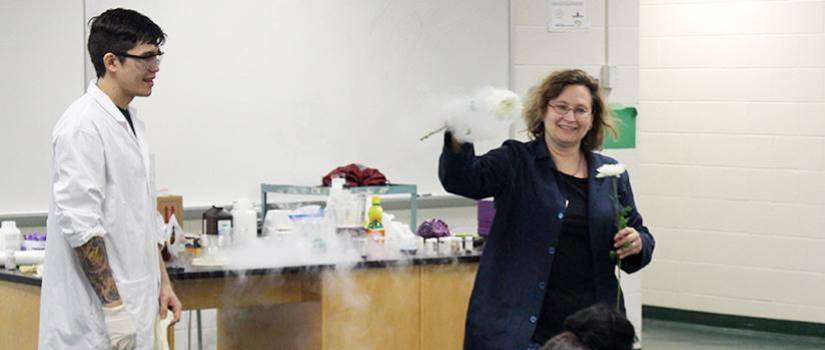Fun. That’s probably not the first adjective K-12 students might associate with chemistry. But it just might be if they’ve seen one of the University of South Carolina’s chemistry shows.
At Eau Claire High School, chemistry professor Linda Shimizu flash-freezes a flower in liquid nitrogen, then smacks it on a desk, smashing it to smithereens. Chemistry graduate student Arthur Korous stirs together two easy-flowing liquids, which turn into a gelatinous mass of glop that students find is endless fun to play with. He mixes a pale yellow solution with a clear one, and it turns dark purple, then almost colorless. Then dark purple. Then colorless. And back and forth every 10 seconds or so.
It’s definitely a fun show, but there’s a lot more to it than that.
“We choose these experiments because they have explanations that the students can understand,” says Shimizu, who has organized a chemistry outreach program at the university since 2000. “The students can make observations, and the experiments highlight the scientific method.”
Shimizu works with undergraduate and graduate student volunteers from the department of chemistry and biochemistry, sending teams of chemistry demonstrators on daylong visits to Columbia-area schools. This spring they’ll reach almost 1,500 students at a dozen schools. They put on several 50-minute shows for small groups of students at each school, each geared toward the students’ grade level.
“You want it to be hands-on, where you can pass things around,” says Shimizu. “That way you can really engage all of the students in the class. And they really enjoy it — the classes get very, very excited.”
But just as important is the opportunity for students to find out what a career in chemistry or other sciences can offer.
“If there’s something that you’re interested in, the best way to see if you’d really like to do that as a career is go try it,” she tells the class at Eau Claire. “And a lot of the internships in science are paid. Every summer, I have high school students working in my lab at USC, and they can get paid to do that.”
She’s also pleased to bear news of a great financial opportunity: Tuition and living expenses are covered for graduate school in chemistry and similar fields.
“They’re all excited to learn that you can get paid to go to graduate school in the sciences,” Shimizu says.
And she’s more than happy to let current university students do the talking. Part of the chemistry show is set aside to let the demonstrators talk about how they got into science, and there are as many routes as there are travelers.
“I was actually a saxophone performance major my first year at Winthrop,” says Korous. He took a year off after that, then found his way from biology to chemistry as an undergraduate. Now a graduate student in organic chemistry, Korous still finds time to play a variety of musical instruments.
“I think hearing those anecdotes from the students – where they grew up, where they went to high school, why they chose the college they went to and how they got interested in science – is really something that speaks to the middle school and high school students,” Shimizu says. “It makes a connection.”
